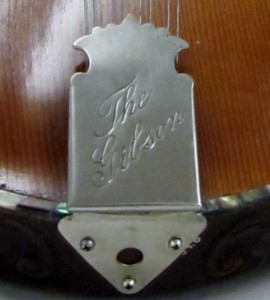I have a strange request friends, so bear with me. Someone out there has an unfinished guitar that they are not quite sure if it’s an Orville or not. This is a turn of the 20th century guitar that was never completed. If you know the owner, could you put me in touch with them? This is for documentation purposes only. I would like to photograph it and take measurements. Thank you to everyone for your help. I don’t know what I’d do without you.
Blog Posts
A Tribute to Orville H. Gibson
Is this cool or what?
On the right is a presentation by Mark Bugnaski, photographer (retired from the Kalamazoo Gazette) that was put on the building at the southeast corner of East Michigan and Burdick in downtown Kalamazoo.
On the left is a photo of the same corner around 1875. Orville’s studio was at 104 East Main St. on the second floor just below the “Business College” sign in 1902 when the Gibson Company was established.
The tribute will still be there for ArtHop in Kalamazoo on September 7. After that it will be taken down.
Orville’s Clients

Joseph Bistolfi, a touring musician born in Italy and living in the United States, was one of Orville’s repeat clients. He commissioned his first Gibson, an 18 string harp guitar for which he paid $150.00, in November 1900.
The instrument body was made of Brazilian walnut, the top ebonized Washington cedar. It also had intricate mother of pearl inlays. This harp guitar took Orville 30 days of continuous work to complete at his East Main Street studio and was reportedly the seventh of its kind that he had made.
Unfortunately, the harp guitar in the photo is not the one commissioned in 1900. Mr. Bistolfi lost his cache of musical instruments along with all his worldly belongings in a Pennsylvania boarding house fire in 1905. More than likely his Orville made harp guitar was amongst those destroyed. Having returned to his room late at night, he was able to warn all other residents in time to get everyone out safely. The boarding house was reduced to ashes.
Even though the Gibson Mandolin-Guitar Manufacturing Company had been making instruments for about two years by 1905, I seriously doubt that Mr. Bistolfi would have accepted a replacement piece that wasn’t made exclusively by Orville himself. I feel Orville would have also insisted upon it. Gregg Miner has dated the one in the photo to early 1906.
The East Main St. Studio, 1897

By September of 1897, Orville had moved his studio to a larger space on the second floor of 104 East Main. In the photo, it’s the second building from the right below where the ‘Business College’ sign hangs. This studio was above the Foster & Post five and dime store.
Among Orville’s output by this time was two complete sets of instruments, one for his own Orpheus Mandolin Club and one for the John W. McLouth Ideal Mandolin Orchestra.

Orville had previously advertised in the newspaper, but at this point he also placed a pictured ad in the 1897 Kalamazoo City Directory. This advertisement also answers my question as to whether he had an exhibit at the 1893 World’s Fair.

The first annual Kalamazoo Street Fair took place October 12-13-14 of 1897. Since his studio was on the second floor, Orville probably displayed his instruments and wares on the sidewalk below as did many other merchants.
Orville Gibson Patent and Studio, 1895
Through his attorney, Lucius C. West, Orville applied for his mandolin patent on May 11, 1895. Entitled “Mandolin,” the patent states that it pertains to  mandolins, guitars, mandolas and lutes. If Orville had applied for it at the height of a guitar craze it may well have been entitled “Guitar.”
mandolins, guitars, mandolas and lutes. If Orville had applied for it at the height of a guitar craze it may well have been entitled “Guitar.”
The patent was granted on February 1, 1898. So, why did it take three years for his patent to be granted? The answer lies with the United States Patent Office.
For a time, the USPO had changed their criteria for granting patents. Previously, they had granted patents on common knowledge alone. They changed their process to actually doing research to see if they could locate the same invention by someone else. This may account for the three year delay in it being granted.
The USPO eventually went back to granting patents on the basis of common knowledge alone and new patents were, once again, granted and issued within a few months of being filed.
Former Gibson employees have said they were told Orville perfected his instrument-making in his garage. After further research, it turns out that when Orville applied for his patent, he lived at 318 South Burdick St. which had a large garage-like structure attached to the back of the residence.

Orville’s studio, 1895. The white house at the left edge of the photo is 318 South Burdick. There is an elongated addition on the back. And attached to that is a long garage-like structure of which the long, low roof can be seen behind the tree on the right.
This photo was taken in 1891 when the new post office was being built at the southwest corner of Burdick and South Street. In the foreground, bricks can be seen stacked neatly encircling the building site. Within its parameter, the foundation was being dug by hand. The Post Office had been completed by the time Orville lived at this address.


